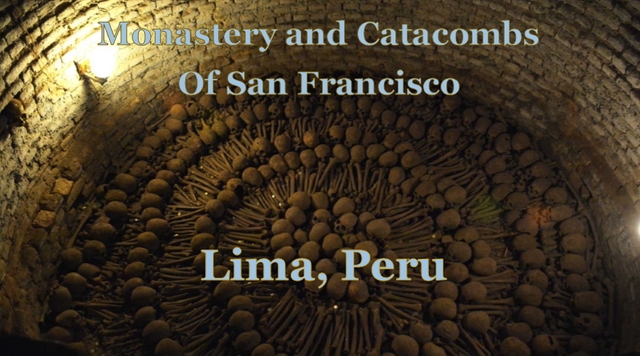
I had complex plans for all of the historical sites I planned to visit during my stay in Lima, Peru. However, my plans went sideways following a robbery shortly after my arrival in Peru. My plans to swim with sea lions and tour the numerous museums and historical sites around Lima were supplanted with visits to four police stations and an afternoon at the US Consulate getting Emergency Passports issued. The time I could have spent taking in the many tourist attractions was squandered away on bureaucratic red tape to facilitate my domestic travel to Cuzco and Machu Picchu. However, I was able to salvage some of my plans on the back side of my trip to Cuzco. The top item on my list of “must see” attractions was the Monastery and Catacombs of San Francisco.
The Monastery and Catacombs of San Francisco are located a short walk from the Plaza Mayor and the central shopping district in Lima. Admission is included in a number of different organized tours of Lima. I had originally intended to visit the Monastery as part of a half-day tour that included several historical sites for $28. Since I did not have time for the complete tour, my wife and I took a taxi to the historical church. Admission was inexpensive at seven soles (less than $3) each. The attraction is open seven days per week from 9:45 AM until 6:00 PM. Tours are conducted in Spanish and English. Visitors wait in a small lobby until the next tour in the language they speak. Our wait was approximately half an hour. The tour itself lasted half an hour to forty-five minutes.
from Google maps
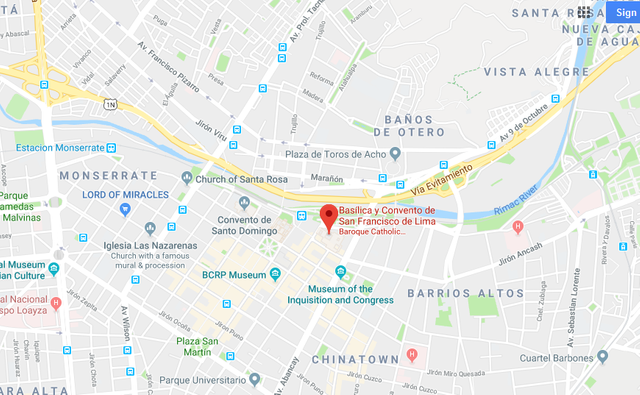
The tour begins to the right of the main entrance. After circling through the interior of the spacious property, visitors end up funneled out through the main entrance from another door off the main lobby. The tour opens with an examination of an intricate wood ceiling above the stairwell leading to the second floor. The amazing geometric pattern created a dome-shaped ceiling without the use of nails. Portions of the ceiling were recreated after the original design was destroyed following an earthquake. Because Lima is located along the Pacific Ring of Fire, it is prone to earthquakes. The design of this building includes flexible materials that absorb most of the damaging motion from earthquakes. Evidence of past earthquakes is noticeable in some of the bowed walls on the second floor.
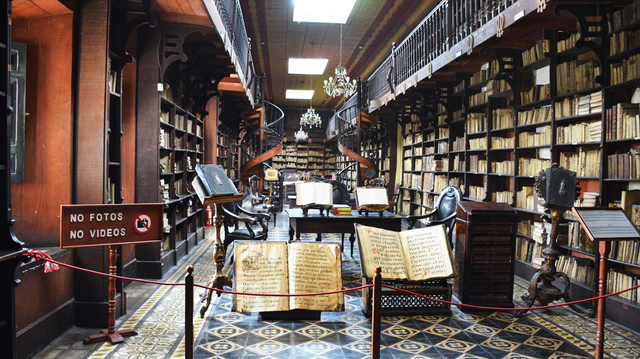
Our next stop was an ancient library with an eclectic collection of volumes covering topics from religion to history. Many of the books are hundreds of years old. The library includes 25,000 examples of antique literature. Two prominently displayed books are hand-crafted song books that were lifted onto a large wooden carousel in the area where the monks worshiped. The song books would lay open on the square wooden podium which could gently spin to allow everyone in the room an opportunity to view the book. The podium has four sides, so four books could also potentially be used. This room was our next stop, providing a panoramic view of the chapel. The intricate wood carving of the individual seats along with depictions of important saints decorate the room.
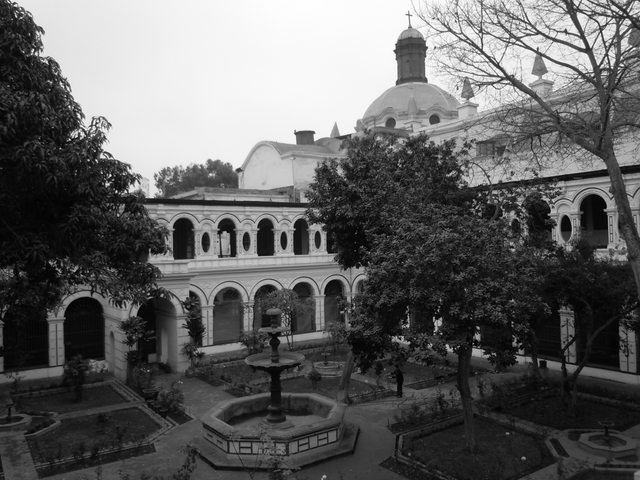
Our tour then took us to the central courtyard, which was lush, but not in the best state of repair. Several fruit trees were evident in the courtyard. The courtyard is surrounded by a covered walkway, with numerous paintings hung along the top of the walls. The walls are decorated in areas with carefully inlaid tile mosaics. Some of the paintings were sent for repairs and were damaged beyond recovery. These murals are recreated directly on the walls where the paintings once hung.
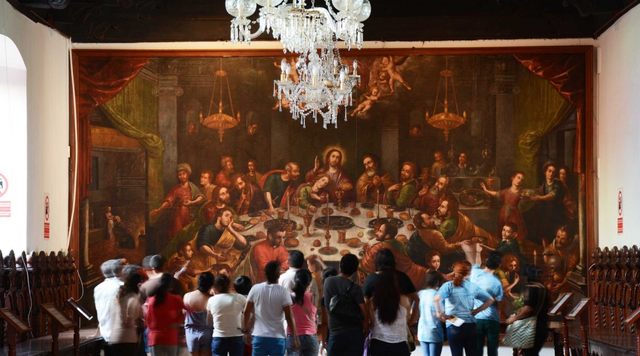
The tour also provided visitors with an opportunity to view freshly painted murals in a meeting room. This room was another that has been damaged by earthquakes. Remnants of the original paintings remain on portions of the wall. We also saw the storage room, where two large silver stands were visible. These are carried by forty men during the feast of Saint Jude and weigh in at 3,000 pounds. The tour also included a visit to the robing room, where rows of long wooden drawers hold the monks robes. The scenes painted around the robing room depict the various saints with indications on how they were murdered. The room also includes a closed display that depicts some historic robes.
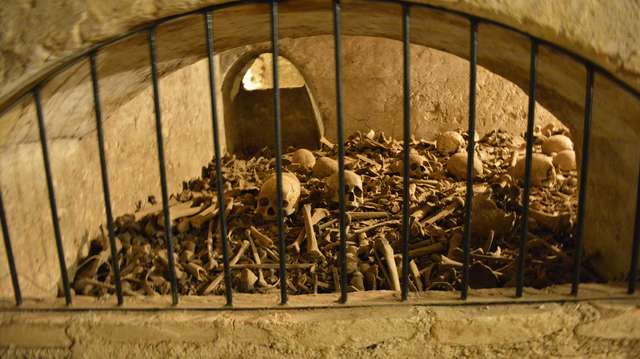
From the robing room, we moved into the catacombs. The catacombs are estimated to hold the remains of at least 25,000 people. The bodies were originally packed in lime and stacked in deep chambers. Burial beneath the church was free. Combined with the fact that many people felt that burial in the church brought them closer to God, the burial chambers quickly filled up. In order to accommodate the continued demand for burial, the monks eventually moved the decomposed bodies into large mass-burial chambers, mixing the bones. When researchers attempted to number the bodies buried beneath the church, they sorted the bones by type. This sorting arrangement is still visible within the individual burial chambers. In the mass burial chambers, they created design with the skulls and bones. I was disappointed to see that callous visitors have discarded trash into the mass graves.
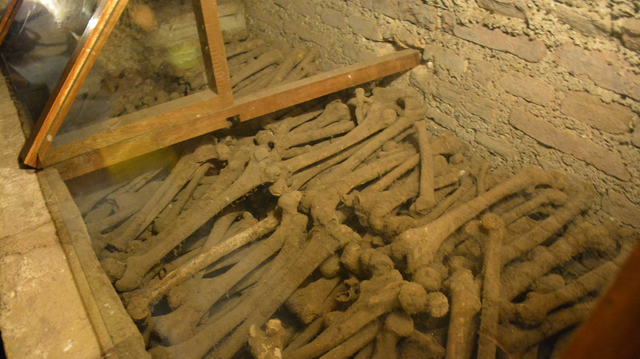
The catacombs have low ceilings and dim lighting. Visitors should be aware of overhead obstacles as they weave around the tombs. Near the largest of the mass burial tombs is the passageway for the deceased. Only the monks were allowed below the catacombs for the burial. The family remained in the chapel as the body was passed down through the floor of the church into the catacombs. From the catacombs, visitors are presented with an interesting view of the chapel. The catacombs are still in use. My group was advised that the most recent burial was three weeks prior.
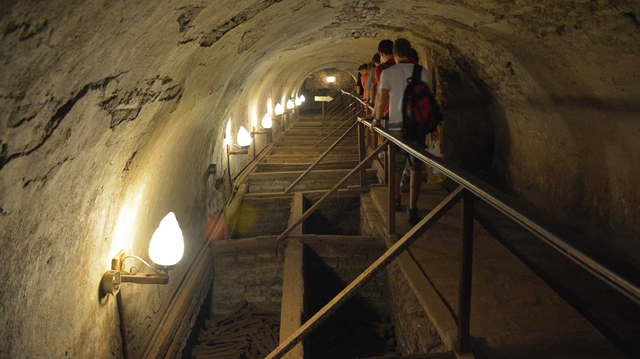
After visiting the catacombs, visitors are channeled back upstairs and are walked to an area that has restrooms and gifts. The gift shop includes a variety of private merchants selling the standard tourist fare of postcards, alpaca gear and carvings. The restrooms cost one sole to use. You do not have to pass through the gift shop to exit. As you enter back into the courtyard of the Monastery, expect to be bombarded with street vendors. The day I visited, it seemed that artwork was the flavor of the day. We were stopped by several art vendors attempting to sell their paintings. The artwork is generally attractive and very affordable if you are interested. I purchased a watercolor painting in Pisac for fifteen dollars. The vendor rolled the painting up inside a hefty cardboard tube to protect it. It traveled home undamaged. The vendors claim the artwork as their own. I tend to doubt those claims. If you don’t actually happen upon an artist who is painting while selling his work, you can probably assume that someone else painted it.
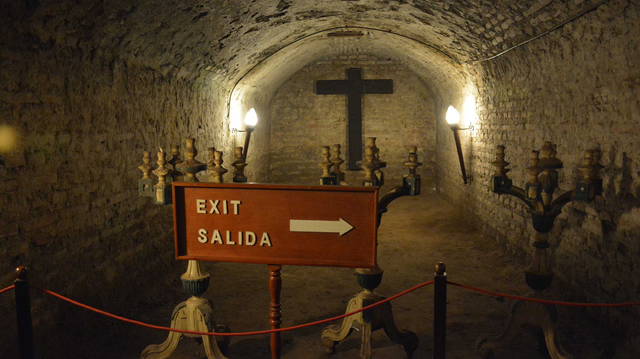
The Monastery and Catacombs of San Francisco were added to the UNESCO World Heritage List in 1991. The church dates back to 1673. It has survived several earthquakes early on, but was heavily damaged during the most recent earthquake in 1970. Evidence of that damage can be seen throughout the tour. The tour itself was well worth the three dollar admission, although I was disappointed at some of the upkeep issues like trash in the tombs and a garden that looked somewhat unkempt. No photography is allowed once you are inside the church. That doesn't seem very thoroughly enforced, either, as members of my group felt at ease snapping pictures while we were in the catacombs. Although I thought it was tacky and disrespectful, it seemed to be a common issue, as I have seen plenty of photographs of the interior at various sites on the internet. Overall, this was an interesting tour that was reasonably priced.
Photography is not allowed during this tour. The photos in this post were taken from the museum website.
it's a great plan brilliant.I like the history,may get to your plan.
Downvoting a post can decrease pending rewards and make it less visible. Common reasons:
Submit
Congratulations, Your Post Has Been Added To The Steemit Worldmap!
Author link: http://steemitworldmap.com?author=coldsteem
Post link: http://steemitworldmap.com?post=monastery-and-catacombs-of-san-francisco-lima-peru
Want to have your post on the map too?
Downvoting a post can decrease pending rewards and make it less visible. Common reasons:
Submit
So sorry to hear about the robbery and the troubles it caused you. But I'm glad that you are not letting it stop you from enjoying the rest of your travels. Thanks for sharing this post. Very interesting!
Downvoting a post can decrease pending rewards and make it less visible. Common reasons:
Submit
Wow, that sounds really interesting. My husband and I did some catacombs in Rome or somewhere around there years ago. I thought it was creepy to be underneath the streets! That's crazy that they had had a burial there three weeks before! In a coffin or just wrapped up like a mummy? Wow, it sounds like a pretty interesting place to visit. It is sad that these Latin American countries (for the most part) do not do a good job of upkeep on tourist sites (or trash). Same thing goes for here and I've seen it other places I have traveled. Thanks for sharing the information!
That stinks about the robbery. We had the same thing happen in Costa Rica on our honeymoon - stole my purse with wallet in it with IDs, money, and passport. We tried a few police stations and then were about to head to San Jose and mess up the rest of our trip when we tried one last time at a police station. They had found my passport and IDs in a plastic bag floating along the edge of the ocean. Apparently all the guy wanted (and regularly takes) was the money and then he tosses the rest of the stuff! We were so blessed!
Downvoting a post can decrease pending rewards and make it less visible. Common reasons:
Submit
Hiya, just swinging by to let you know that this post made the Honorable mentions list in the latest edition of the #TravelDigest!
Downvoting a post can decrease pending rewards and make it less visible. Common reasons:
Submit